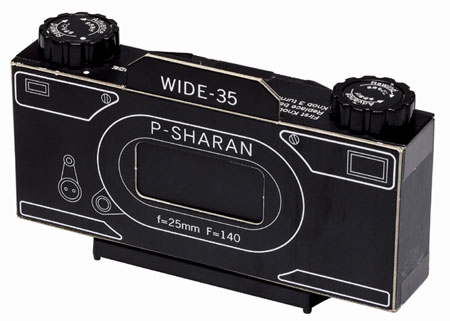
Monday, April 26, 2010
Sharan pinhole camera
Starting to put together a Sharan pinhole camera and stumbled across this very detailed account of a build. A great resource.


Sunday, April 18, 2010
Accurate real time clock
I have been using the DS1307 RTC from Sparkfun, but it loses time quite consistently - should have read some more the comments on the Sparkfun page.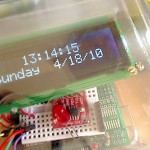
So a much better clock and more accurate is the ChronoDot, also available from Evil Mad Scientists, at $15 with back up battery.


So a much better clock and more accurate is the ChronoDot, also available from Evil Mad Scientists, at $15 with back up battery.

Thursday, April 15, 2010
markduino on breadboard
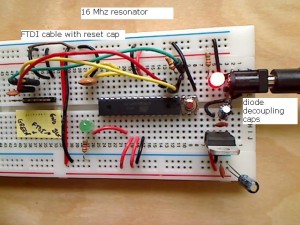 So after lots of procrastinations, I made an arduino on a breadboard using Tom Igoe's ITP work and added a protection diode, additional 0.1uF decoupling capacitors (2), and wired a socket to use a FTDI cable from adafruit. Schematics based on the Boarduino, which I love. This version can now be transferred to a perf board to make a more permanent arduino without bells and whistles.
So after lots of procrastinations, I made an arduino on a breadboard using Tom Igoe's ITP work and added a protection diode, additional 0.1uF decoupling capacitors (2), and wired a socket to use a FTDI cable from adafruit. Schematics based on the Boarduino, which I love. This version can now be transferred to a perf board to make a more permanent arduino without bells and whistles.NO POWER FROM USB CABLE - this 5V is NOT connected so need power even when downloading.
IMPROVEMENT: Power on left side and header pin for downloading on right so wiring is neater
Wednesday, April 14, 2010
Plant moisture meter
I started working on a Forest Mims related moisture meter using a NPN transistor and an ammeter (multimeter actually)
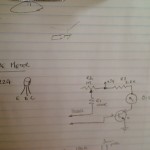 and then thought about an arduino version! a low and behold Faludi has done it, changed it to a voltage, then sold it as Botanicalls, a really cool product. So changed by circuit to Faludi's version, tested the analog signal with a voltmeter and all looks good. The new circuit look like this
and then thought about an arduino version! a low and behold Faludi has done it, changed it to a voltage, then sold it as Botanicalls, a really cool product. So changed by circuit to Faludi's version, tested the analog signal with a voltmeter and all looks good. The new circuit look like this 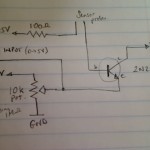 and there is an interesting tutorial on converting an ammeter circuit into one that can use a voltmeter. ALso talks about how to measure internal resistance of meter.... Still a little confused about the use of the trim pot though.
and there is an interesting tutorial on converting an ammeter circuit into one that can use a voltmeter. ALso talks about how to measure internal resistance of meter.... Still a little confused about the use of the trim pot though.
 and then thought about an arduino version! a low and behold Faludi has done it, changed it to a voltage, then sold it as Botanicalls, a really cool product. So changed by circuit to Faludi's version, tested the analog signal with a voltmeter and all looks good. The new circuit look like this
and then thought about an arduino version! a low and behold Faludi has done it, changed it to a voltage, then sold it as Botanicalls, a really cool product. So changed by circuit to Faludi's version, tested the analog signal with a voltmeter and all looks good. The new circuit look like this  and there is an interesting tutorial on converting an ammeter circuit into one that can use a voltmeter. ALso talks about how to measure internal resistance of meter.... Still a little confused about the use of the trim pot though.
and there is an interesting tutorial on converting an ammeter circuit into one that can use a voltmeter. ALso talks about how to measure internal resistance of meter.... Still a little confused about the use of the trim pot though.
Tuesday, April 6, 2010
Robotics blog
Interesting belt tensioner at http://www.iheartrobotics.com/
Monday, April 5, 2010
arduino xbee temperature sensor - UPDATE
Been a long time since I looked at this project. Using Tom Igoe's Making Things Talk book, I got an Xbee with an attached potentiometer to send ADC data to an XBee attached to a PC.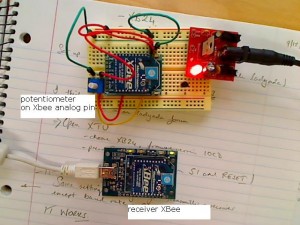
Then the data was parsed in processing to plot a dual bar graph of sensor value (ADC) and signal strength.
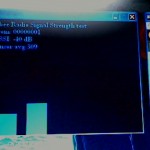
The drioids.it XBee breakout board can be powered by up to 12V (on-board voltage regulator), and also has outputs for 3.3V.
To run a temp.sensor or other sensors will probably require a separate 5V circuit. The current circuit has the pot connected to AD0 (PIN 22) of the XBee, so could feasibily attach sensors to AD1,2,3 (all at 3.3 V).
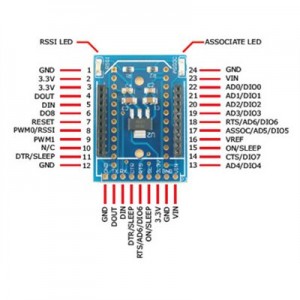

Then the data was parsed in processing to plot a dual bar graph of sensor value (ADC) and signal strength.

The drioids.it XBee breakout board can be powered by up to 12V (on-board voltage regulator), and also has outputs for 3.3V.
To run a temp.sensor or other sensors will probably require a separate 5V circuit. The current circuit has the pot connected to AD0 (PIN 22) of the XBee, so could feasibily attach sensors to AD1,2,3 (all at 3.3 V).

Thursday, April 1, 2010
Make minature scenes
Photoshop instructions for minature photos
Subscribe to:
Posts (Atom)